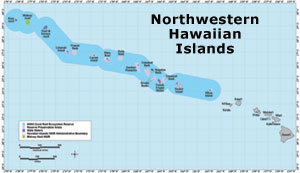|
 Sanctuary Designation Moving Forward Sanctuary Designation Moving Forward
NOAA is in the process of designating the Northwestern Hawaiian Islands Coral Reef Ecosystem Reserve as our nation's 14th national marine sanctuary. Sanctuary designation is a high priority for the Administration and protection of the region is highlighted in the Administration’s U.S. Ocean Action Plan. The living coral reef colonies are the foundation of an ecosystem that hosts more than 7,000 marine species, fish, sea turtles and birds, with many found no where else in the world.
As part of the designation process, NOAA is consulting with the State of Hawai‘i, Western Pacific Fishery Management Council and U.S. Fish and Wildlife Service to develop management options that would be consistent with the proposed sanctuary’s goals and objectives. NOAA is in the final stages of developing draft regulations for the proposed sanctuary and a Draft Environmental Impact Statement (DEIS) and Draft Management Plan. Developing a DEIS and draft management plan are required by Congress when a federal agency is proposing any significant action that could impact the environment.
To learn more about the work underway and how you can provide input, please visit the reserve Web page.
Educators Bring Experience Back To Hawai‘i Classrooms
In August 2005, the reserve office mounted its first education expedition to increase further understanding of the archipelago and to develop educational materials about the area for Hawai‘i classrooms. Several Hawai‘i educators were chosen to participate. Cruise activities included fish and invertebrate identification, seabird banding, archaeological studies, studies of island and atoll geology, and maritime archaeology. Based on their experience, the educators are developing lesson plans that meet Hawai‘i Department of Education standards. Placing teachers aboard a NOAA research vessel enhances their ability to educate Hawai‘i students and other educators about this important part of Hawai‘i’s natural and cultural legacy.
Research Answering Questions About Archipelago
Reserve scientists undertook their first full year of research aboard the new NOAA Ship Hi’ialakai in the waters surrounding the Northwestern Hawaiian Islands where little is known about the plants and animals that live there. Studies began in April with mapping deep-water areas and ended in October with an annual assessment and monitoring cruise. The data collected during the mapping cruise is integral to documenting the habitat types as part of the sanctuary designation process, and the long-term monitoring and assessment provides important information on the health and composition of shallow water marine ecosystems in the island archipelago. The research and monitoring of coral reef animals and plants will enable scientists and managers to better understand how populations change naturally over time and how similar organisms that live in different areas may be related to one another. All this information will help to create a baseline from which to design effective management strategies for this special place.
Exclusive Stories for the Web
Research Partnership with Hawaii Institute of Marine Biology
The reserve has entered into a partnership with the Hawaii Institute of Marine Biology, part of the University of Hawaii, to develop research programs focused on the Northwestern Hawaiian Islands that address reserve management questions on ecological connectivity, ecosystem condition and coral health. Questions such as ecological connectivity between different parts of the Hawaiian Archipelago are critical when determining how best to manage the area in an ecosystem based framework, and to decide which areas need the highest level of protection due to ecological sensitivity, exceptional diversity, or as nurseries or breeding grounds. The researchers are attempting to answer these questions through genetic studies, acoustic-tagging of large predatory fish to see how far they may travel, and studies that look at issues of biodiversity. In 2005, researchers collected specimens, acoustic-tagged sharks and other large fish, and conducted coral bleaching and disease studies aboard the May Hi’ialakai cruise. Additional data analyses and research produced draft documents on the threats posed by alien and invasive species, and the synthesis of new measures of diversity and ecological integrity utilizing existing monitoring data.
Visitor Center Educates Thousands About Hawaii’s Remove Archipelago
Mokupäpapa: Discovery Center for Hawai‘i’s Remote Coral Reefs continues to educate thousands of visitors at this interactive facility that utilizes a variety of learning tools to teach visitors and school students about Hawai‘i’s oldest islands and atolls. The center emphasizes marine life, and the natural and cultural resources contained within the nation’s largest conservation area.
Mokupäpapa features a 2,500-gallon saltwater aquarium containing fishes found in the Northwestern Hawaiian Islands and offers colorful bilingual interpretive panels in English and Hawaiian, which explain the breadth and depth of the natural and cultural heritage of the region. Interactive exhibits with touch-screens and video vignettes cover topics ranging from giant, apex predators to tiny, yet poisonous invertebrates. The center enables visitors to explore for themselves what life on the reefs is like.
The Discovery Center also contains a large program room that provides a theater environment for multimedia educational programs and classes. The program room is available to community groups for educational use.
Plans for 2006
Reserve staff will continue implementing the next steps in the sanctuary designation process. The draft environmental impact statement and draft management plan for the proposed sanctuary will be released for public comment in June 2006 and public hearings will be held statewide. Public education and outreach programs will include a statewide tour of the Susan Middleton and David Littschwager “Archipelago” photographic exhibition and teacher workshops using the newly released Navigating Change curriculum. Scientists will embark on several science cruises.
|






